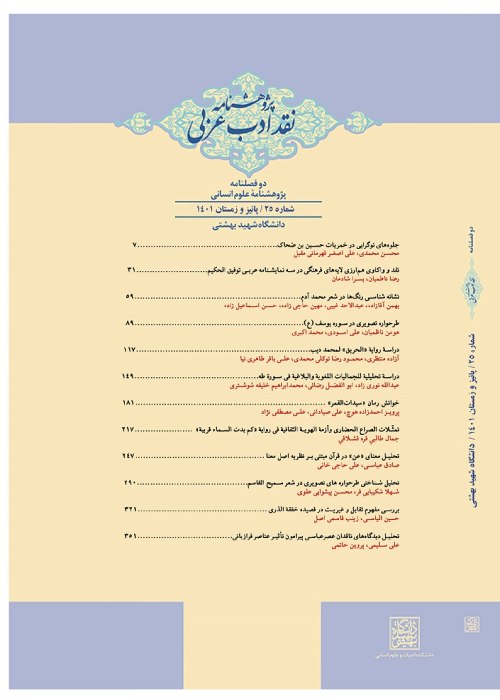A study of graphological deviation and its implications in Saadi Youssef's poetry
Author(s):
Article Type:
Research/Original Article (دارای رتبه معتبر)
Abstract:
Graphological deviation which is one of the eight types of deviations in Leach's classification is used by the poet when the words alone do not have enough meaning to convey a message. It gives the readers the opportunity to have their own interpretation in their interaction with the text. In graphological deviation, the poet goes beyond the usual norms in writing and attracts the reader's attention to the text. The poet makes new shapes by changing the text and makes the poem more sensible and tangible and shares the joy of artistic creation with the reader. Among the contemporary poets, the Iraqi poet Saadi Youssef tried to take his poetry as far away from sentences, words and sounds and as close to living tangible shapes.In other words, he tried to turn poetry into a visual creature rather than just a readable one. Saadi Youssef is one of the poets that graphological deviation has taken a prominent place in his poetry; in such a way that the use of graphological deviation can be considered as his stylistic feature. Therefore, most of his poems are great enough to be worth reading. In the present study, the most important types of graphological deviation in Saadi Youssef's poetry are discussed. The aim of this study is to answer the following questions by examining and analyzing the types of graphological deviation in Saadi Youssef's poetry. What are the most common types of graphological deviation in Saadi Youssef's poetry? What methods did the poet use to in order to have graphological deviations in his written texts? What are the semantic meanings of this type of deviation?
Methodology
In the present study, an attempt is made to describe the examples of this type of deviation in the poetry of this Iraqi poet by descriptive-analytical method and by citing evidence that shows graphological deviation, and then to explain that how much the discussed deviation has naturally and unpretentiously grown in his peoms. Discussion and results
Modern poetry is no longer just an arrangement of words together and in a definite format. If in the past, poetry was considered merely a verbal art, the poets today, however, try to convey their message to the audience as much as possible by using all the lexical and non-lexical possibilities. For this reason, sometimes a poet is silent in the lines of his poem and expects the reader to discover and understand his unspoken words through his utterances. The importance of this attitude is that the audience of the poem is in the center of importance and comes out of the passive listening body and gains a share in the joy of artistic creation. In graphological deviation, the poet goes beyond the usual norms in writing and attracts the reader's attention to the text. The poet makes new shapes by changing the text and makes the poem more sensible and tangible and shares the joy of artistic creation with the reader. According to Jeffrey Leach, the permissible limit to graphological deviation is only to the extent that communication is not interrupted and accentuation can be interpreted. Saadi Youssef paid special attention to graphological deviation in his collection of poems.The most repetitive examples of graphological deviation in Saadi Youssef's poetry are: separating the letters of words and using spaces, stepping and vertical writing of poetic lines, using geometric shapes and visual forms of numbers, repetition of words and coordination between words meaning and its written form,and change of font size and use of English words. Using spaces and the repetition of letters and phrases are two different types of graphological deviation that have frequently been used in Saadi Youssef's poetry. The main purpose of using visual cues in Saadi Yousuf's poetry is to help the audience read the poem correctly, highlight the desired text, share the artistic pleasure with the audience, and attract more attention of the audience through visualizing the text. Where he uses space, he paid attention to the time and patience of the audience, while preserving their share of free perception. In most cases, the purpose of changing the font and using the numbers was to emphasize the desired phrases and numbers. In other cases, the purpose of using visual cues is to help the audience see the poem in addition to hearing it and find it more tangible and therefore more believable. Graphological deviation far from any ostentation has flowed into the poet's poetry in a completely natural way and has helped the audience in receiving the message. Conclusion
Findings show that the most important examples of graphological deviation in Saadi Youssef's poetry are: separating the letters of words and using spaces, stepping and vertical writing of poetic lines, using geometric shapes and visual forms of numbers, repetition of words and coordination between words meaning and its written form,and change of font size and use of English words. The purpose of using these visual signs is to attract the reader's attention and make the poetic words more effective in the field of emotion and also to emphasize the objectivity of meaning and to develop a poetic message.Keywords:
Language:
Persian
Published:
Arabic Literature Bulletin, Volume:10 Issue: 21, 2022
Pages:
323 to 348
magiran.com/p2442432
دانلود و مطالعه متن این مقاله با یکی از روشهای زیر امکان پذیر است:
اشتراک شخصی
با عضویت و پرداخت آنلاین حق اشتراک یکساله به مبلغ 1,390,000ريال میتوانید 70 عنوان مطلب دانلود کنید!
اشتراک سازمانی
به کتابخانه دانشگاه یا محل کار خود پیشنهاد کنید تا اشتراک سازمانی این پایگاه را برای دسترسی نامحدود همه کاربران به متن مطالب تهیه نمایند!
توجه!
- حق عضویت دریافتی صرف حمایت از نشریات عضو و نگهداری، تکمیل و توسعه مگیران میشود.
- پرداخت حق اشتراک و دانلود مقالات اجازه بازنشر آن در سایر رسانههای چاپی و دیجیتال را به کاربر نمیدهد.
In order to view content subscription is required
Personal subscription
Subscribe magiran.com for 70 € euros via PayPal and download 70 articles during a year.
Organization subscription
Please contact us to subscribe your university or library for unlimited access!



